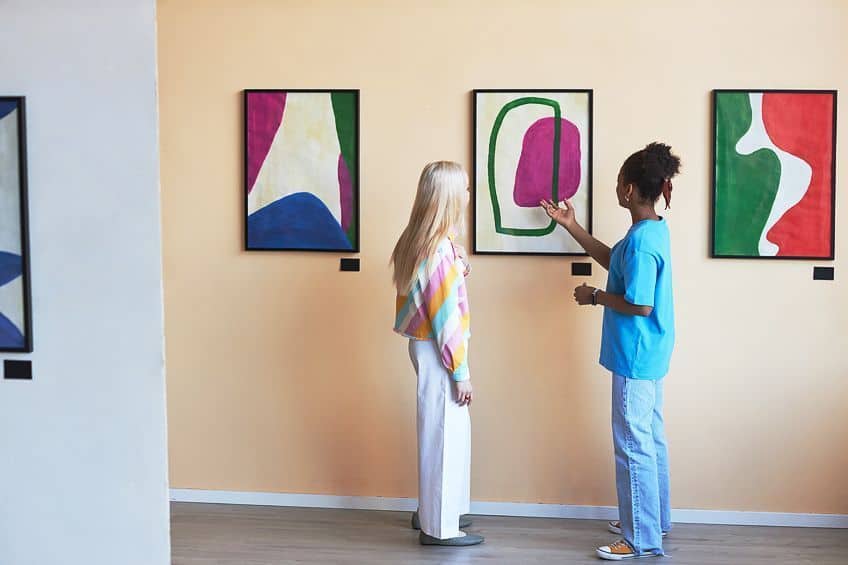How to Start an Art Business – An Easy Guide for Aspiring Artists
Are you ready to turn your passion for art into a thriving business? Embarking on the journey of starting an art business is like stepping into a colorful canvas of possibilities. From crafting captivating pieces to navigating the art market’s intricate brushstrokes, this adventure promises a blend of creativity, strategy, and a dash of entrepreneurial spirit. Get ready to unleash your artistic vision and dive into the exciting world of building your own art empire!
Key Takeaways
- Crafting a clear business plan is essential for direction and growth.
- Legal and logistical preparations underpin a stable art business framework.
- Effective marketing and relationship-building are pivotal for long-term success.
Developing Your Art Business Plan
Starting an art business is a venture that requires careful planning and dedication. This process begins with a comprehensive understanding of your target market and the development of a unique artistic identity. By analyzing the art industry’s trends and consumer behavior, aspiring entrepreneurs can tailor their strategies to carve out a niche for themselves. A good business plan is not only a roadmap for guiding your business to growth but is also essential for navigating through the complexities of the art market.

Operating a successful art business also involves handling the logistical aspects, such as legal requirements, licenses, and the effective management of inventory and finances. The artistic aspect of the venture must be complemented with strong marketing and sales strategies. Pricing artworks strategically and promoting them effectively to build a loyal collector base are key elements to making the business thrive. Consistency in quality and service, alongside networking and word-of-mouth marketing, plays a crucial role in establishing a successful art career.
Clarifying Your Mission and Business Goals
An art business plan should start with a clear mission statement that defines the purpose and direction of the business. The mission should encompass not only the artistic vision but also the business objectives.
Business goals should be specific, measurable, attainable, relevant, and time-bound (SMART), setting a clear trajectory for growth and profitability.
Establishing Your Brand and What It Stands For
Building a brand identity involves more than just a memorable logo; it’s about cultivating a unique selling proposition that sets the art business apart. This requires a deep understanding of the target market and how the business’s art addresses their needs and preferences. Branding extends to every aspect of the business, from the art itself to customer service and marketing materials.

Conducting Market Research
Comprehensive market research is fundamental in identifying the target market and understanding market trends. This research should consist of analyzing data on potential customers, their purchasing habits, and preferences related to art. Data collection methods can range from surveys and interviews to studying industry reports.
This information is pivotal in guiding business decisions and marketing strategies.
Analyzing Competition
An art business must understand the landscape of its competition to succeed. This involves identifying direct and indirect competitors and critiquing their strengths and weaknesses. A competitive analysis should reveal gaps in the market that the business can exploit and inform the development of competitive strategies.

Creating Your Financial Plan
Lastly, a thorough financial plan is critical. This includes startup costs, ongoing expenses, pricing strategies, and revenue projections. The financial plan should outline required funding sources, strategies for maintaining cash flow, and long-term plans for financial sustainability and profitability.
It should also include a break-even analysis to determine when the business will likely become profitable.
Legalities and Logistics
Navigating the formalities of starting an art business is crucial. Artists must ensure that their venture is legally sound and operationally efficient by addressing business registration, tax obligations, and operational setup.

Registering Your Business
For any artist turning their passion into a business venture, choosing a business structure is the first step. The choice between a sole proprietorship, limited liability company (LLC), or a corporation influences liability, taxes, and compliance requirements. They should then register the chosen entity with the secretary of state. Most businesses will require a business license, which varies depending on location and industry. Art businesses may also need specific licenses and permits to operate legally.
When considering the structure for your art business, several options can suit your needs.
A sole proprietorship is the simplest to establish, although it exposes the owner to personal liability. Opting for an LLC provides liability protection but involves a bit more complexity in setup. On the other hand, forming a corporation is ideal for larger enterprises with shareholders, offering distinct advantages in terms of structure and governance. Choose the structure that aligns best with your business goals and growth plans.
To kickstart your art business officially, follow these key steps in the registration process. Begin by checking the availability of your chosen business name to ensure uniqueness and compliance. Next, file the necessary registration documents with the secretary of state, laying the legal foundation for your enterprise. Don’t forget to secure any required licenses and permits, ensuring that your business operates smoothly within legal frameworks. With these steps completed, you’re ready to embark on your artistic journey with a solid legal footing.
Understanding Taxes and Finances
Art businesses must obtain an Employer Identification Number (EIN) from the IRS, which is essential for tax purposes, especially if the business hires employees. Understanding the distinction between personal expenses and business expenses is vital for tax reporting and deductions. Artists should separate finances by opening a business bank account, ensuring transparency and simplifying accounting. Staying informed about tax obligations, including income, self-employment, and sales tax, ensures compliance and financial health.

Setting Up Operations
Operational logistics involve organizing the backend of an art business to create a smooth workflow. Ensuring compliance with state and federal regulations is part of this process. An art entrepreneur must establish clear operational protocols for production, inventory management, shipping, and receiving. Depending on the scale of the business, this might require setting up a studio or workshop space that complies with local zoning laws and safety standards.
To ensure smooth operations for your art business, follow this essential checklist.
First, establish a dedicated studio or workspace where your creativity can flourish. Next, focus on producing and managing your inventory efficiently to meet demand and optimize resources. Finally, set up effective shipping and receiving protocols to ensure timely delivery and customer satisfaction. With these key elements in place, your art business can thrive with organized and streamlined operations. By addressing these legalities and logistics, artists lay a solid foundation for their art business, positioning themselves for success in the competitive market.
Marketing and Sales Strategies
Marketing and sales strategies are crucial for turning artistic talent into a profitable venture. A robust approach involves establishing a strong online presence, developing effective pricing and sales tactics, cultivating a loyal customer base, and expanding market reach while being adaptable to change.

Building an Online Presence
Artists must leverage online platforms to showcase and sell their work. A professional website, preferably built with a reliable website builder like Wix, should elegantly display the artist’s portfolio. Integrating an online store and utilizing social media platforms for promotion are key.
Regular blogging and sending out newsletters can help in keeping the audience engaged.
Developing Pricing and Sales Tactics
Determining the right price for artwork involves a calculated pricing strategy that considers costs, market value, and target customers. Artwork must be priced competitively yet ensure a fair profit. Sales can be augmented through various sales channels including Etsy, personal websites, and local art fairs.

Building a Loyal Customer Base
To nurture a loyal customer base, artists should focus on branding and customer experience. Engaging with customers through social media, appreciating their purchases, and providing excellent after-sales support can foster loyalty.
Referral programs and exclusive offers for repeat buyers are effective tactics.
Expanding Your Market Reach
Expansion of market reach might involve exploring new sales channels or tapping into different demographics. Participation in local art fairs and exploring wholesale options are examples. Paid advertisements and collaborations with influencers can also increase visibility.

Staying Informed and Adapting to Change
The art market is dynamic, and successful artists stay informed about industry trends. They adjust their marketing strategy according to the latest marketing tools and customer preferences.
This might involve updating pricing, trying new promotional techniques, or exploring fresh marketing channels.
Managing Your Art Business
Successful art business management hinges on curating an exceptional product line, developing robust customer relationships, and implementing operational efficiencies for sustained growth.

Curating Your Product Line
An artist’s portfolio is the backbone of their art business. To ensure a strong product line, they must assess the quality and diversity of their artwork. It is essential to have a mix of original art, art prints, paintings, sculptures, and even greeting cards to cater to a wider audience. Inventory management is crucial, and keeping track of stock levels helps in preventing oversupply or stockouts.
Maintaining a high standard of quality across all products reinforces the art brand’s reputation.
Nurturing Customer Relationships
Customer service should never be an afterthought in an art business. A loyal customer base is built through excellent service, responsive communication, and reliable shipping practices. Tailoring services such as art classes or consultations can enhance the value offered to clients. Further, an art business should have a recognizable logo and a clear positioning strategy that serves as its unique selling proposition, aiding in cultivating a strong, trustworthy relationship with customers.

Operational Efficiency and Growth
Scaling an art business involves not just creative talent, but also operational savvy. Integrating systems for better handling of orders, shipping, and inventory can streamline the business and allow for more time to be spent on producing art. Exploring art business ideas like online marketplaces, partnerships, and social media can provide avenues for expansion. An art brand should be agile, constantly evaluating its growth strategies to adapt to the ever-evolving market.
As you wrap up your artistic odyssey into the realm of entrepreneurship, remember that starting an art business is not just about selling artworks—it’s about cultivating a brand, connecting with your audience, and continuously evolving as an artist. Embrace the challenges as opportunities for growth, stay true to your creative vision, and let your passion for art fuel your journey towards success. With a palette of perseverance and a canvas of innovation, your art business can flourish, leaving a lasting impression on the vibrant tapestry of the art world. Cheers to your artistic endeavors and may your business thrive like a masterpiece on display!
Frequently Asked Questions
What Strategies Can I Use to Start an Art Business from Home With Limited Resources?
One can start an art business from home by crafting a clear business plan that outlines the artistic identity, target market, and financial goals. Leveraging free or low-cost online marketing tools like social media can also be a strategic way to reach potential customers without a significant upfront investment.
How Much Initial Investment Is Typically Required to Launch an Art Business?
The initial investment for launching an art business varies. It can range from a few hundred to several thousand dollars, depending on factors such as studio space, materials, marketing, and necessary equipment. Artists should prepare a budget to anticipate these costs and manage their resources effectively.
What Are Some Viable Avenues for a Beginner to Sell Art and Start an Art Business?
Beginners can explore selling their art through online marketplaces, social media platforms, local art fairs, and community events. Creating a professional website can also provide a centralized platform for showcasing and selling their work. Networking with other artists and connecting with galleries interested in emerging talent are additional avenues to consider.
Isabella studied at the University of Cape Town in South Africa and graduated with a Bachelor of Arts majoring in English Literature & Language and Psychology. Throughout her undergraduate years, she took Art History as an additional subject and absolutely loved it. Building on from her art history knowledge that began in high school, art has always been a particular area of fascination for her. From learning about artworks previously unknown to her, or sharpening her existing understanding of specific works, the ability to continue learning within this interesting sphere excites her greatly.
Her focal points of interest in art history encompass profiling specific artists and art movements, as it is these areas where she is able to really dig deep into the rich narrative of the art world. Additionally, she particularly enjoys exploring the different artistic styles of the 20th century, as well as the important impact that female artists have had on the development of art history.
Learn more about Isabella Meyer and the Art in Context Team.
Cite this Article
Isabella, Meyer, “How to Start an Art Business – An Easy Guide for Aspiring Artists.” Art in Context. April 4, 2024. URL: https://artincontext.org/how-to-start-an-art-business/
Meyer, I. (2024, 4 April). How to Start an Art Business – An Easy Guide for Aspiring Artists. Art in Context. https://artincontext.org/how-to-start-an-art-business/
Meyer, Isabella. “How to Start an Art Business – An Easy Guide for Aspiring Artists.” Art in Context, April 4, 2024. https://artincontext.org/how-to-start-an-art-business/.











